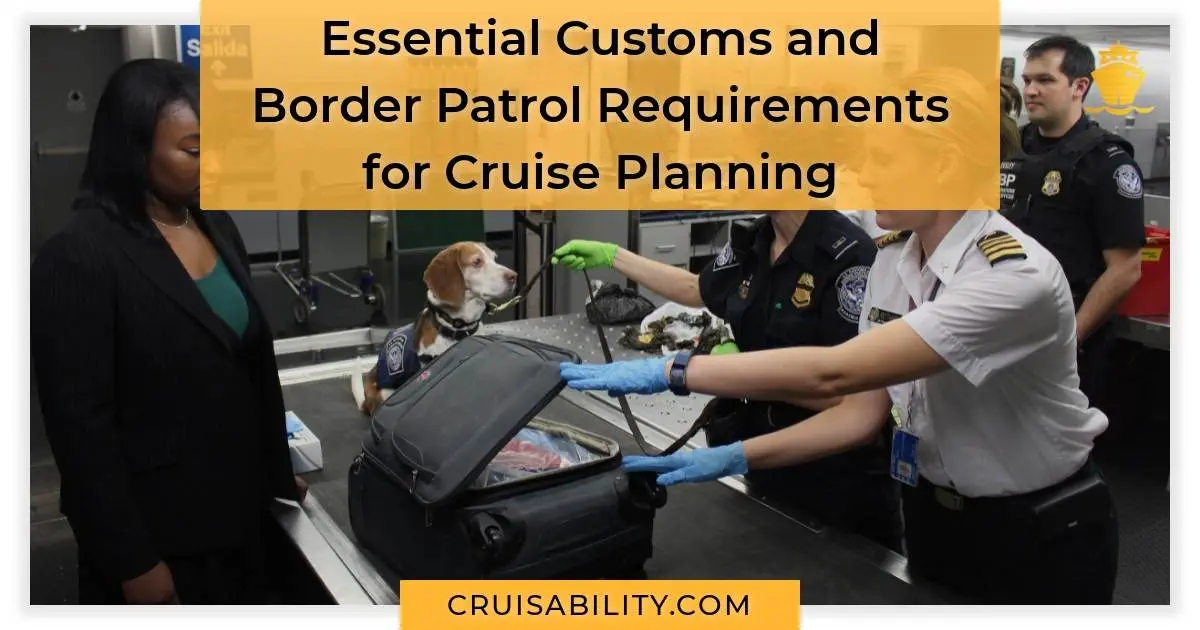Are you planning a cruise and wondering what it takes to get through Customs and Border Patrol (CBP)? Look no further! In this article, we will discuss essential Customs and Border Patrol requirements and provide tips to ensure smooth sailing.
CBP is responsible for enforcing laws against terrorism, illegal immigration, narcotics trafficking and other threats to the United States. As part of their mission, CBP is in charge of inspecting passengers, cargo and vessels entering the country. For a cruise, this means that passengers must go through CBP inspection upon arrival and departure.
To make sure your cruise goes as smoothly as possible, it’s important to understand the Customs and Border Patrol requirements. This article will cover the documents you need to bring and the steps you must take to pass inspection. We will also provide advice on how to minimize your wait time in line. With the right preparation, you can make sure your cruise goes off without a hitch. So, let’s dive in and explore the essential CBP requirements for cruise planning.
Table of Contents
Required Documentation for International Travel
Passengers traveling on a cruise ship must have the necessary travel documentation, which includes passports, visas, and travel permits when traveling internationally. It is important to ensure that your passport is valid for at least six months beyond the duration of your trip. Some countries also require visas, so it is essential to check the entry requirements for your itinerary.
Apart from passports and visas, passengers may also need other documents to enter certain countries. Some countries require proof of vaccination, travel insurance, or may charge port fees. It is important to research and obtain all necessary documents before embarking on your cruise.
Guidelines for Packing Luggage
Packing for a cruise can be overwhelming, but it is important to be mindful of customs and border patrol regulations. Passengers must comply with checked baggage restrictions and carry-on restrictions, and also be aware of prohibited items.
Checked baggage allowance varies by cruise line and itinerary, but it is generally recommended to pack only what is necessary. Passengers should also label their bags with their name, address, and phone number.
Carry-on bags must comply with size and weight restrictions and should not contain any prohibited items, such as firearms or sharp objects. Duty-free allowances should also be considered when packing.
Customs Declaration Process
All passengers traveling on a cruise ship must complete a customs declaration form. This form includes information on items purchased abroad, food items, and any other items that are being brought into the country.
It is important to answer all questions truthfully and accurately. Passengers who fail to declare all items can face fines and penalties or even be denied entry into the country.
Security Screening Procedures
Passengers must pass through security screening procedures before boarding a cruise ship. This process includes metal detectors and x-ray machines, which screen all carry-on and checked luggage.
Some passengers may also be required to undergo additional screening procedures, such as a pat-down search or a hand-held metal detector scan. Passengers should be aware of any medical equipment that may set off the alarm and notify security personnel before the screening process.
Arrival and Departure Procedures at Ports of Call
Passengers traveling on a cruise ship will visit different ports of call throughout their itinerary. Each port of call has its own procedures for disembarking and boarding the ship.
Passengers must comply with all local customs and immigration procedures when visiting different countries. It is important to carry all necessary documents when disembarking at ports of call, such as passports and visas.
What are the essential Customs and Border Patrol requirements for passport application when planning a cruise?
When planning for the ultimate cruise passport application, it is essential to ensure that all Customs and Border Patrol requirements are met. This may include providing proof of citizenship, a passport photo, and the necessary application form. Additionally, it’s important to allow sufficient time for processing before the cruise departure date.
Consequences of Non-Compliance with Regulations
Passengers who fail to comply with customs and border patrol regulations can face fines, penalties, and even legal consequences. Smuggling prohibited items can result in criminal charges and impact future travel plans.
Passengers should also be aware of the impact non-compliance can have on their travel insurance coverage. Failure to comply with entry requirements can also result in denied boarding or cancellation of the itinerary.
In conclusion, Complying with customs and border patrol regulations is essential for a successful and enjoyable cruise vacation. Ensuring that all necessary travel documentation is obtained and adhering to baggage restrictions will help avoid any issues upon embarkation. Passengers should also be aware of prohibited items and answer all customs declaration questions honestly. By following these guidelines, passengers can enjoy their cruise vacation without any complications.

